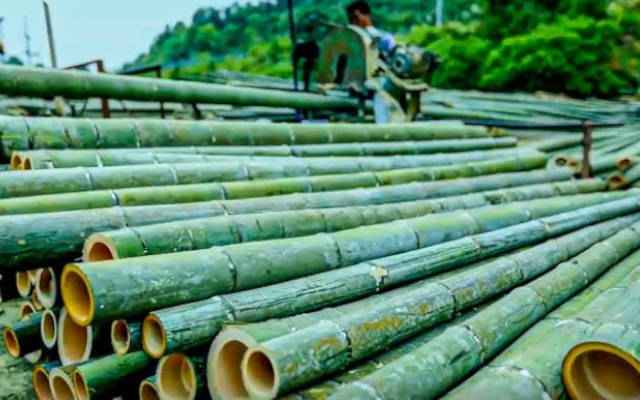Bamboo vs. Petroleum Plastics: Can Natural Composites Drive the Future of Automotive Design?

Bamboo-based composite could replace petroleum-derived plastics in car interiors and structural components
By EVWorld.com Si Editorial Team
As the world grapples with mounting plastic pollution and the automotive industry seeks sustainable alternatives, a promising material is emerging from an unlikely source: bamboo. Researchers from IIT Guwahati in India have developed a bamboo-based composite that could replace petroleum-derived plastics in car interiors and structural components. Meanwhile, Ford Motor Company and U.S.-based Pivot Materials are exploring similar paths, reviving interest in natural fibers first tested in the 1940s.
The Global Plastic Problem
Plastic pollution has reached crisis levels. According to the United Nations Environment Programme, over 400 million tons of plastic are produced annually, with nearly half used for single-use products. Microplastics have infiltrated oceans, food chains, and even human bloodstreams. In response, global negotiations are underway to draft a legally binding treaty to curb plastic waste by 2025.
Automotive Plastics: A Snapshot
Modern vehicles are composed of nearly 50% plastic by volume. These materials offer durability, weight reduction, and design flexibility—but they’re derived from fossil fuels and contribute to long-term environmental degradation.
| Plastic Type | Use Cases | Replacement Potential |
|---|---|---|
| Polypropylene (PP) | Bumpers, dashboards, cable insulation | High |
| ABS | Dashboards, trims, wheel covers | High |
| Polyurethane (PUR) | Seats, headrests, soundproofing | Moderate |
| Polyvinyl Chloride (PVC) | Door panels, upholstery | Limited |
| Polycarbonate (PC) | Headlight lenses, windows | Low |
India’s Breakthrough: Bamboo Epoxy Composite
Researchers at IIT Guwahati have engineered a composite using Bambusa tulda fibers and bio-based epoxy resin. The material exhibits high tensile strength, thermal stability, and low moisture absorption—ideal for dashboards, bumpers, and door panels. It’s also renewable and locally abundant, making it cost-effective for Indian manufacturing.
Dr. Poonam Kumari, lead researcher, notes that the composite could extend beyond automotive use into electronics, aerospace, and sustainable construction. However, questions remain about resin sustainability and end-of-life recyclability.
Ford’s Legacy and Modern Revival
In 1941, Henry Ford unveiled a prototype car body made from hemp, flax, soy, and ramie—an early experiment in natural fiber composites. Today, Ford researchers like Alper Kiziltas are revisiting bamboo, coffee chaff, and rice hulls for interior components. Bamboo’s strength and compostability make it attractive, but cost and processing complexity remain hurdles.
North American Supply Chain Challenges
To scale bamboo composites in North America, a vertically integrated supply chain is needed:
- Clumping bamboo cultivation in southern states like Georgia and Florida
- Fiber treatment and resin blending facilities
- Partnerships with Tier 1 suppliers for pilot programs
- Regulatory support and sustainability incentives
Companies like Pivot Materials in Detroit are already producing bamboo-reinforced thermoplastics, but widespread adoption is still in its infancy.
Environmental Considerations
Bamboo spreads via rhizomes—underground stems that can be invasive if unmanaged. Clumping species like Bambusa tulda are preferred for controlled cultivation. Proper land-use planning and containment strategies are essential to avoid ecological disruption.
Plastic vs. Bamboo: Manufacturing Comparison
| Stage | Petroleum Plastics | Bamboo Composites |
|---|---|---|
| Raw Material | Crude oil derivatives | Bamboo fibers + bio-resin |
| Processing | Polymerization, molding | Fiber treatment, resin transfer |
| Environmental Impact | High CO₂, non-renewable | Renewable, lower emissions |
The Road Ahead
Bamboo composites offer a compelling path toward greener automotive design. Their strength, renewability, and aesthetic appeal make them ideal for interior components. Yet, challenges in cost, resin sustainability, and supply chain logistics must be addressed.
As global pressure mounts to reduce plastic waste, innovations like IIT Guwahati’s bamboo composite—and Ford’s renewed interest in natural fibers—could help reshape the future of mobility. The key lies in scaling responsibly, investing in infrastructure, and aligning with consumer and regulatory demand for sustainable solutions.
Original Backlink
Views: 301
Articles featured here are generated by supervised Synthetic Intelligence (AKA "Artificial Intelligence").
